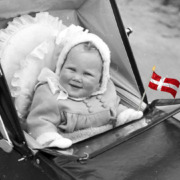Arriving in Denmark: Some tips from my experience
August in Denmark brings the first signs of fall: a crisp chill in the air, the changing color of the leaves, the annual posters warning drivers to be aware of small children riding their bikes to school for the first time.
And foreign university students in the local 7-11, asking that their buns be warmed up.
I saw a newly-arrived young American student in my local 7-11 this morning, asking that her newly-purchased bun be warmed. The 7-11 clerk told her sorry, but there were no bun-warming services available at that branch.
She wasn’t too pleased, but it’s always a mistake to expect U.S., U.K., or Asian-level concepts of customer service in Denmark: in this egalitarian country, nobody serves anybody, and if they do they are frequently grumpy about it. You and the store clerk are equals, and nobody’s going to warm anybody’s buns unless it was agreed to in the original deal.
While I didn’t dare approach the angry American bun-woman, I thought it might be useful to her and to others list a few tips for arriving in Denmark at any time of year. You know, random things I wish people would have told me before I arrived.
Packing for Denmark
First of all, how should you pack for Denmark? Bring lots of basics – socks, undies, T-shirts, jeans, sweaters, exercise clothes. These are going to be really expensive in Denmark. Layering is good – jean jackets, leather jackets, and sweaters are great. Anything waterproof will come in handy.
Bring scarves – in a country where most people’s clothing style runs from black to navy blue, scarves are the main form of fashion expression for both men and women. Warm gloves and a hat are good, too, but there’s no need to pack like you’re planning an expedition to the Arctic. Unless you plan on hiking in Sweden or Norway, you probably won’t need a heavy parka.
And unless you’re going to work in a bank, you probably don’t need a suit. Danish people are pretty casual, even at work.
First steps: The secret and not-so-secret CPR
The first thing you’ll do after you arrive in Denmark is to get a 10-digit CPR number, your own personal number in Denmark’s ‘Central Person Registry’. The CPR is the basic unit of social control: you need it to get medical care, library books, a mobile phone, a bank account, or an apartment rental contract. A side effect is that in Denmark, the police will always know precisely where you live.
If you’re going to a university in Denmark your school will give you the paperwork necessary to apply for a CPR; if you’re coming to work in Denmark, your employer will probably set you up, but you’ll have to go apply in person at a central office somewhere near your Danish home.
Although the first six numbers of your CPR are your birthday – making it pointless to lie about your age in Denmark – the last four are supposed to be kind of secret. Of course, it’s not really secret because you hand it out all the time to sign up for fitness centers and car rental contracts and other various services. But it’s sort of a semi-secret. Suffice to say that if someone gets your CPR number, they can use it for minor mischief, like giving your identification on the trains if they get caught without a ticket.
Bills must actually be paid
You don’t need a ticket to board most local trains and some buses, but you are expected to buy one anyway, and if the controllers do happen to turn up that day and find out you don’t have precisely the ticket you need for the zone you are currently in, don’t count on them to have any mercy on a cute (or crying) foreigner. They will take you off the mode of transport, take your name and CPR number, and you will get a giant bill in the mail.
And because everything is centralized in Denmark, the bill really does have to be paid. They will find you. In general, it’s good to pay your bills the first time you get them in Denmark. I know in some countries and cultures, people just treat the first bill like kind of a suggestion, and wait to see if a second or third reminder will show up. That doesn’t work in Denmark, where the second bill will come with a large fine added.
Cash needed only for street musicians
If you don’t pay your bills or your taxes, you get put into RKI, a central registry of people who don’t pay their bills, and you will find your financial life sharply restricted – you won’t be able to get a phone, rent a place, or possibly even get a job that will allow you to pay your overdue bills. Just pay all your bills on time if you can, and if you can’t, get in touch with the people you owe money to and work out a payment plan.
You’ll need a bank account when you arrive in Denmark. I would suggest one of the bigger banks (Danske Bank, Nordea, Jyske Bank), all of which have netbanks in English and some experience dealing with foreigners. Ask for a Dankort, which is the universal debit card; in Denmark, cards pretty much pay for everything. You only need cash to reward street musicians. Almost everyone else takes Dankort or the app version, MobilePay, which you should download as soon as possible. Even the homeless people who sell newspapers on the street in Denmark take mobile payments.
Bring recipes
Plan to cook your own food as much as possible. Outside of downtown Copenhagen and Aarhus, Denmark is not really a restaurant culture. Most sit-down restaurants are still expensive (at least DK150 per person, not including alcohol), open limited hours, and sometimes exhibit bizarre customer service. More than once, I’ve walked into a nearly empty restaurant on, say, a Tuesday night in August and been told that all the tables were booked and they would not serve me. It is quite hard not to take this personally.
So plan on doing a lot of cooking for yourself, and bring your recipes. If you need special spices or ingredients, bring them with you. Desperate foreign cooks desperately looking for condensed milk, jalapeños, Marmite, or canned pumpkin are a standard feature of the online forums for foreigners in Denmark. Danish vegetables and herbs are also quite specialized: fresh dill and parsley is everywhere, but cilantro, for some reason, is almost impossible to find. Asian, or Indian, or Arab greengrocer markets in the bigger cities are a good source, or you can grow your own on your windowsill.
Fear the post office
Don’t count on having a friend sending missing ingredients or anything else to Denmark: postage costs are extremely high, and any package from outside the European Union worth more than DKr 80 (about 10 euros or US$12) will be delayed while the customs people mess around with it and then hit with 25% MOMS plus a DKr 160 administration fee. If you need to order something online while living in Denmark, always order from within the EU to avoid this type of customs headaches.
Those are my top tips, although I have many more (Apartments in Denmark have to be flawless and spotless when you move out, and you’ll still have trouble getting your security deposit back! If you’re a Christian, avoid the boring Danish state church and find an international congregation! Turn on ‘week numbers’ into your electronic calendar – the Danes love to say such-and-such is happening in Week 7 or Week 42, but no one ever knows precisely when those weeks are!)
And if you’re really in trouble, you can always ask one of your Danish colleagues or fellow students for help. But you have to ask.
It is a cultural quirk that Danes will often not come up to you and offer help: they don’t want to break into your private space, or insult your independence, or suggest that you’re not capable of handling a situation yourself.
But you ask for assistance on a personal level, they will generally go out of their way to help you.
Unless, of course, you want your bun warmed.
[icon name=”facebook-square” class=”fa-3x”] [icon name=”twitter-square” class=”fa-3x”][icon name=”instagram” class=”fa-3x”]
Buy Kay’s books about Denmark on Amazon, Saxo, Google Books, Apple Books, Barnes & Noble Nook, or via our webshop.
Image mashup copyright Kay Xander Mellish [current_year]








I’d love to find a nice Danish man who can warm my buns.